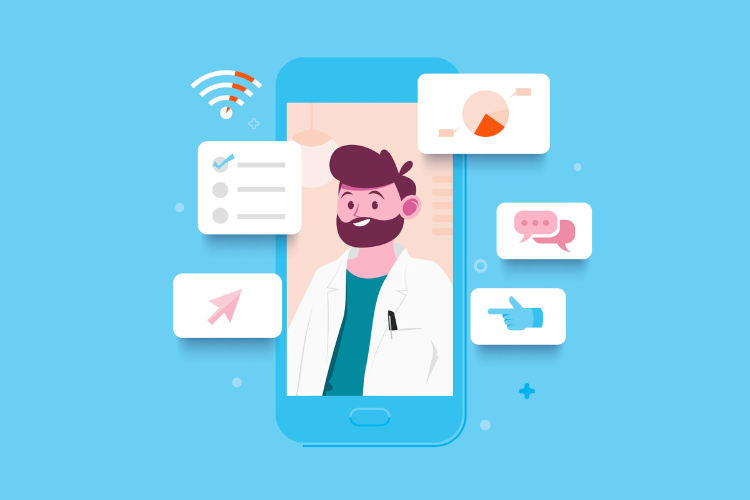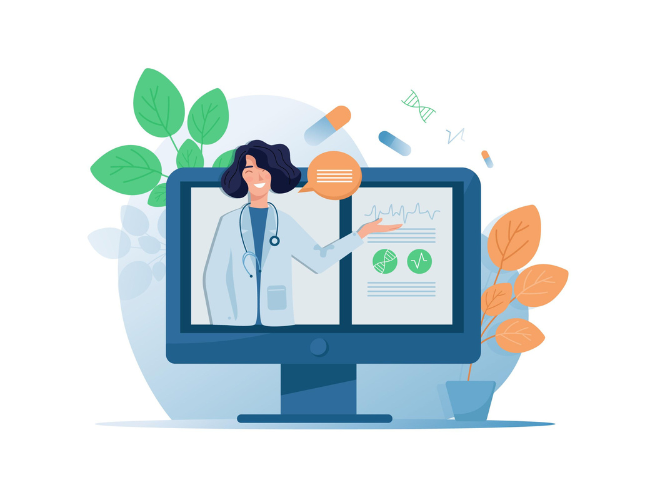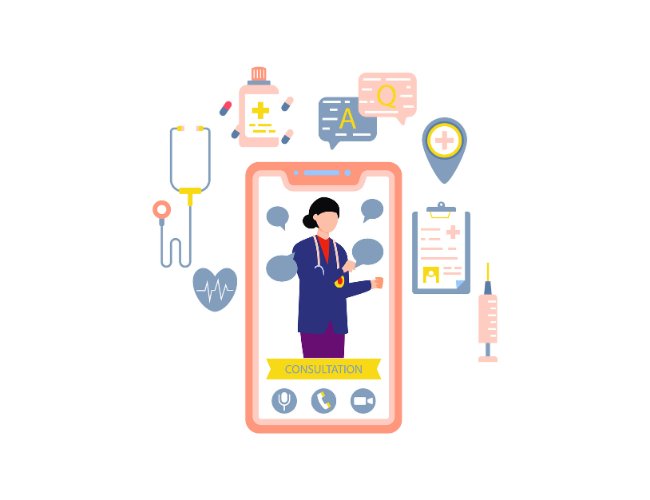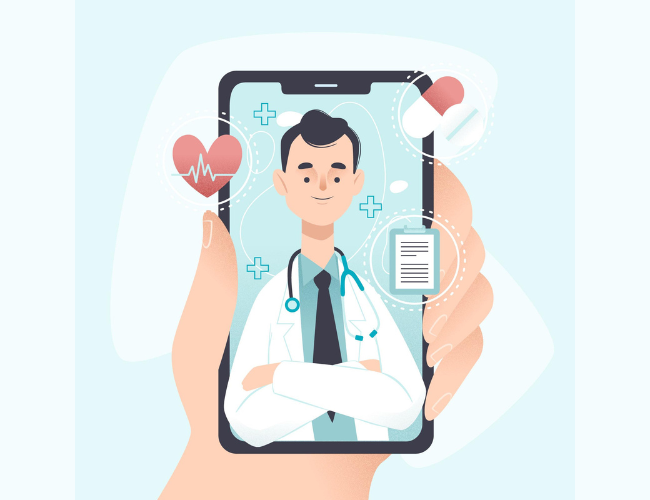Trying to figure out the best possible approach to move ahead with telemedicine app development for your business? Or seeking insights regarding the services you can target or APIs you can leverage to help you gain a positive ROI from your development cycle? Whatever your requirement might be, this blog covers almost everything you need to get around this discussion!
COVID dramatically pushed the “remote” culture, leading to the continuous rise in demand for robust and compliant telemedicine app development projects. From a passionate entrepreneur to a gigantic hospital chain, everyone is eager to upscale their business to the next level with a dedicated app built around their roster of medical professionals and collaborations.
While some applications try focusing on a general diagnosis to consultation model; some medical establishments seek the expertise of software development teams, experienced with building custom telemedicine applications that tackle the challenge of performing a niche diagnosis remotely. With the introduction of more cutting-edge technologies, the domain of possibilities in the telemedicine industry is only expanding.
Before we discuss the use cases any further, let’s briefly touch on – what telemedicine app development refers to. Just to get everyone on the same page!
Your Custom Telemedicine Solution Awaits!
What is a Telemedicine App?
Telemedicine apps enable patients to remotely mention their issues to a back-end model that connects them to a medical professional of relevant expertise. It’s a simple concept, allowing patients and medical professionals to meet remotely.
A general belief within the market is that telemedicine is here to replace offline visits completely. However, considering the technology’s current approach, that is certainly not the goal. Telemedicine aims to assist with the initial diagnosis, helping to determine whether the problem needs a physical examination or it can be treated remotely. And secondly, addressing any updates that follow up after a physical session. Here’s some more light on the primary use cases –

[1] Digital Therapy
The client can book a session using the application based on the therapist’s availability. They can then hop on a video conference to go through their routine.

[2] Remote Diagnosis
The patient can mention the symptoms they have been noticing based on which the application’s chatbot follows a decision tree and decides whether to diagnose the issue itself or consult a doctor.

[3] Discuss Progress / Prescription Updates
After an offline session, the patient can remotely share updates with the doctor and ask for any changes in the prescription without the need for any additional visits.
Benefits of Telemedicine App Development
Although at a somewhat nascent stage, telemedicine apps still improve some of the traditional medical practices by a significant amount. Making the lives of both the patients and the medical professionals easier, some of these improvements include –

[A] Convenient Access To Doctors
A traditional visit to the doctor’s clinic might force a patient to spend hours in the lobby waiting for their turn, even after booking an appointment weeks before. And let’s be honest, nobody wants to go through that! Telehealth apps become a life savior in this scenario, as the patients are neither forced to take a day off from work, nor waste one of their precious weekends over this. Plus, even if an appointment gets delayed for some reason they can simply reschedule it to their next calendar opening without any major hiccups!

[B] Cost Effective In Comparison to Traditional Methods
Another major factor that prompts patients to avoid medical checkups is the cost of a single appointment. Shifting to a telehealth app by leveraging telemedicine app development services takes off a significant amount of the service provider's overheads, like the facility space allotment and accommodation costs. Patients also save on travel expenses while enjoying greater options! For instance, if a patient in the UK wishes to consult a doctor who earned their MBBS in USA, Japan, or another country, they can simply book an appointment online and skip the flights. Looking at the shift in the approach of healthcare checkups, insurance companies have also started covering the cost of online consultations. Taking away yet another advantage of offline checkups.

[C] Easy Diagnosis For Remotely Located Patients
Several parts of the world still lack access to proper medical infrastructure in their local areas. They need to travel for hours for any health-related assistance. Now imagine a patient traveling for hours for a weekly checkup, reaching the clinic, and waiting for hours again. Telemedicine apps take away a major chunk of this baggage. The patient might still have to travel a few times for any major operations or tests, but traveling for regular check-ups can be completely dodged.

[D] Readily Available EHRs For Doctors
Having an EHR linked to every patient comes in handy in situations when doctors are attending patients continuously, they can quickly scan through their records before any recommendations to mitigate the room for any errors. It also acts as a handy way to update every patient's medical record in a standardized format, making it easier to refer to in the future instead of juggling through reports and prescriptions, which was the situation for a long time.

[E] Simultaneous Consultation is Possible
Using telemedicine applications, doctors attend to a higher number of patients daily. In some cases, doctors can club patients with similar symptoms in a common meeting and consult multiple patients simultaneously, on the flipside patients get quick recommendations for their non-chronic issues. As impressive as it sounds from the revenue angle, for parts of the world where the medical workforce is insufficient compared to the demand, this efficiency boost lands as a blessing.
Our Telemedicine App Development Services

Custom Telemedicine Feature Development

Appointment Scheduling

Video Consultation

Authorized Direct Messaging

E-Prescription Generation & Management

EHR Integration

Easy Billing Options

Additional Resources Addressing FAQs
Get Complimentary Consultation
How We Create Telemedicine Apps for Our Clients
The development of a telemedicine app needs a strategic approach considering the purpose and impact it will be creating for its end users. It is crucial to prioritize the user experience and the reliability of the application, as a wide range of demographics will be accessing the application –

[i] Ideation
Like every successful software, telemedicine app development requires a thorough understanding and planning of the approach and the technologies that need to be leveraged to get the best outcome from this endeavor.

[ii] Designing
Building an intuitive and easygoing layout has to be one of the highest priorities, mainly because the application will be leveraged by a vast demographic of users. If the approach is sub-optimal users may struggle to navigate through the application. It’s important to keep the instructions clear and the language as simple and basic as possible.

[iii] Select APIs
Thanks to the availability of dedicated telemedicine APIs, the developers do not have to build every single functionality from scratch. With enough research and a thorough understanding, these APIs can cut down the development time to a fraction of what the development time otherwise would have been. There are specific APIs that fit in a bunch of different use cases, we will be discussing them in an upcoming section.

[iv] Check Compliance
Speaking from experience, working on a product for the healthcare industry cannot afford any hint of slacking in the compliance area. Which is where compliance with the essential guidelines becomes a necessity. Some popular compliance checks include –
- HIPAA or Health Insurance Portability and Accountability Act
- GDPR or General Data Protection Regulation
- FDA or Food and Drug Administration
- HITECH or Health Information Technology for Economic and Clinical Health
- And other globally acknowledged & local regulatory checks.

[v] Development
With the due diligence completed, the developers start building the architecture and functionalities as per the discussed guidelines. The project is typically completed in different phases or milestones. At the end of each milestone, the clients test the progress and discuss any queries they might have, upon clarification, they give the green signal to start the development further.

[vi] QA and Testing
Once the development is over, the telemedicine app is handed over to the quality assurance team. They thoroughly check the solution across several test cases, to identify any possible issues with the application. If identified, the issue is promptly reported to the development team for a swift fix. Once resolved, the solution is double-checked before closing the ticket. Once all the raised issues are resolved, the product is officially ready to be delivered to the end users.

[vii] Deployment and Maintenance
The finished Telemedicine application is launched to the end users. In most cases, medical organizations want the application to reach as many users as possible, so Google‘s Play Store & Apple’s App Store are the ideal platforms for deployment. If the application also has a web version, a specific domain is assigned to it. Once the end users start using the application seamlessly for the first time, the development phase is officially over. The clients still have the option to keep the developers on-cue for scheduled maintenance by paying them a percentage of the development cost annually.
Typical Patient Journey on a Telemedicine App
Now that the application is ready, it is time to look at the user’s perspective, primarily the flow of the core functionalities of the application –

[a] Downloading / Visiting the Application
Once the clients get to know about the application, ideally, they would either download it from the respective app marketplace of their mobile’s OS or they would access the web application with the link provided to the domain.
For the mobile, the application page on the marketplace should describe the product in a concise but clear way. Also, it is important to make sure the reviews/ratings for the application are above 4.0 out of 5 stars. This should be the baseline for any telemedicine application.
For the web application, it is crucial to evaluate the overall SEO of the domain and make it easily accessible to the users without any crashes, or inflated loading times, leading to high bounce rates. These high bounce rates are a disaster for an application trying to gain new users and will inevitably shed away a major chunk of initial opportunity. Google’s Pagespeed insights and Search Engine Console can be a great help to uplift the SEO game.

[b] Logging In
The next standard flow in the procedure would be to get them to register as a user. Keeping the pages simple and precise should be the main focus. The application should not ask for a lot of information before offering anything to the customer. This may build up a level of frustration that may lead to form abandonment. Getting these users to come around for a second attempt will be difficult.
The best approach here would be to let them log in to the application with basic credentials like email and password (verification if necessary). Once they’re in, they will be exposed to the services that they can avail. Now when they try to access these services, the application can ask for the necessary additional information, being eager to try out the services, the chances of them abandoning a form, become significantly lower.

[c] Initial Symptoms Checkup
Once the due diligence is over, the patients are prompted to go through an initial symptom check-up to let the back end perform its diagnostics. Based on the inputs, the backend logic filters out the issue(s) the patient might be facing. In certain cases, the issue is simple and can be identified and prescribed for by the backend logic. However, when the issues cannot be determined or there is a certain degree of ambiguity, the patient is advised to book an appointment.
Some medical organizations leverage AI for the initial symptom diagnosis, while others rely on their proprietary logic. Whatever the approach might be, it is always advised to run the diagnosis through an actual doctor for approval before prescribing the patient any intense medication or antibiotics.

[d] Booking Appointment
Upon the patient’s consent, the application checks through various predefined fields to find the right healthcare expert for the patient, based on the type of issue, the doctor’s expertise, the patient’s address (in case a physical visit was required), availability of both parties and much more.
Once confirmed, the application then provides the patient with reminders about their appointment. It is crucial, as they are not visiting the clinic and are ideally attending it in between their daily busy routine.

[e] Connected To a Doctor For Diagnosis
Once connected to the doctor, there are typically two ways the appointment can go –
- Based on the report that the application has generated, the doctor performs their own diagnosis. They may ask some additional questions with obviously a much higher level of intricacies and understanding of the situation. If that is enough to diagnose the issue, the doctor prescribes the needed medications.
- Otherwise, the doctor recommends certain tests that might help them to get to the crux of the situation. The doctor can also ask the patient for a physical visit if needed. This is where the matchup during the appointment booking process comes in handy.

[f] Payment
The positioning of the payment phase depends on the organization's preference, some companies prefer to keep this as a mandatory requirement before the appointment, while other organizations ask you to clear the owed amount before generating a copy of the prescription, or before providing the option to schedule a second appointment.
Regardless of the position, the payment process has to be seamless, and to ensure that the application must provide multiple options for the users to make their payments. All backed by reliable payment gateways to guarantee data security and a seamless payment experience.

[g] Relevant Medication Delivered
The next step in the flow mainly occurs outside the application. A copy of the prescription that was sent to the patient is also sent to the telemedicine application’s pharmaceutical partner, along with the necessary information about the customer. The partner then creates a delivery ID and sends it to the telemedicine application and the patient. The prescribed meds are then packed and shipped to the patient’s address.
On the application, the patient can track the shipment and get updates. Depending on the network of the telemedicine application and its tie-ups, the delivery can take anywhere between a few days to a few minutes. Depending upon the e-commerce and quick commerce distribution of the collaborating pharmaceutical companies.

[h] Follow-Up Checks
After a decided time frame. The application finally prompts the patients for an update on their health via notifications or a simple call. If the response hints towards them being fully recovered, the application can ask for concluding feedback. In other situations –
- Improved health but not entirely
- No progress whatsoever
The app suggests scheduling another appointment so that the doctor can further diagnose the situation and make decisions accordingly.
Telemedicine App Supporting APIs
As we briefly discussed, the cost of creating a telemedicine app can be significantly lower if the right APIs are used for its development. Here are some of the APIs along with their offerings that can be leveraged for various use cases within the telehealth solution –
[1] Health Gorilla API: It provides API to access various healthcare-related data sets starting from EHRs, laboratory reports, and other recorded information. It is also compliant with the Fast Healthcare Interoperability Resources (FHIR) standards.
Commonly used for the creation of data exchanging modules for existing healthcare systems and risk management tools.
[2] DrChrono API: This API is affiliated with Apple as their official mobility partner for healthcare requirements. It is well known in the industry for pioneering EHR-based applications with telemedicine functionalities in iPhone and iPad devices.
It has become a popular choice for creating modules within various categories of iOS-centric applications.
[3] WebRTC API: The abbreviation expansion for WebRTC refers to Web Real Time Communication, which highlights the API's ability to enable real-time communication between patients and healthcare professionals.
It provides a secure environment for both parties to share confidential healthcare information in an encrypted manner, minimizing any chances of data vulnerabilities.
[4] Validic API: Remember we mentioned simultaneous consultation? This API makes it possible. It allows a single healthcare provider to manage the data of over 200 patients simultaneously.
Healthcare professionals can use this data to provide patients with a healthcare plan or monitor their progress by keeping an eye on several metrics.
[5] Symptomate API: This is an AI-enabled symptom-checking tool that allows users to self-assess themselves, providing them with a robust set of options to provide their symptoms with other basic information. Based on the data provided, the application identifies the possible issues the user might be facing.
This acts as a good way to identify common issues that can be prescribed for without a diagnosis from a healthcare professional, saving time and resources.
[6] TrueVault API: As the name suggests, TrueVault integrations act as a one-stop solution for storing and managing healthcare data while being compliant with HIPAA and other privacy standards.
It is a popular choice for developing telehealth applications that need to store the personal healthcare information of a large number of patients.
[7] HealthTap APIs: Their primary USP stands that they host the world’s largest searchable FAQ library with responses provided by verified doctors. It also provides tools for Big Data analytics along with a CRM dedicated to medical operations.
It also has an AI-enabled triage system that assigns the appropriate healthcare professionals to the patients seeking their expertise.
Conclusion
Telemedicine app development has played a pivotal role in taking the traditional methods of initial medical diagnosis to the digital age. As new technologies and medical breakthroughs continue to emerge, the coverage of the currently available telemedicine applications will vastly expand.
Besides, as internet access continues to spread globally, the applications will receive an increasing footfall, uplifting the opportunity for the entire market. If you want a piece of this cake, and wish to develop a telemedicine solution that takes your healthcare vision to the next level, then you will need a technical backbone with an extensive amount of experience in this field to back you up! (We’re talking about us
Talk to Our Medical App Development Experts!
FAQs
The exact price of a telemedicine application largely depends on the number of integrations and the overall complexity. A basic telemedicine application with communication and scheduling enabled, and a few integrations, you are looking at a ballpark of US$ 30,000 – US$ 50,000.
Meanwhile, a complex AI-enabled telemedicine application with its own dedicated CRM and a wide range of integrations would cost somewhere around US$ 100,000 – $200,000. Although it is a very rough estimate, depending on the intricacies and the entire requirement list, the cost can largely vary.
The recent years of technological advancements pushed the domain of use cases that a telemedicine or healthcare app can perform. This led to the creation of several categories for these apps including –
- 1. Real-Time Video Consultation Apps
- 2. Telepharmacy Applications
- 3. Symptom Checking and Recommendations App
- 4. Mental Health Checkup and Tele-Neuropsychology Application
- 5. Problem-Specific Therapy Exercise Applications
- 6. Live Monitoring and Tele-Emergency Apps
AI is leveraged in the following ways while discussing its use cases relating to the healthcare industry –
- 1. Natural Language Processing – Enhanced FAQ Modules, EHR Summarization, Optimal Data Storing.
- 2. Computer Vision – Image Analysis, Surgical Assistance, Remote Patient Monitoring.
- 3. Machine Learning – Symptom Based Predictions, Drug Discovery, Healthcare Resource Allocation.
- 4. Robotic Process Automation – Medical Administration Work, Rapid Patient Registration, Inventory Automation.
- 5. Deep Learning – Wearable Device Data Analysis, Enhancing Other AI Technologies.
There is an armada of telemedicine applications that serve users globally, here are some of the popular ones from the lot –
- 1. MyChart
- 2. HealthTap
- 3. Doctor On Demand
- 4. Amwell
- 5. MDLive






.png)
.png)